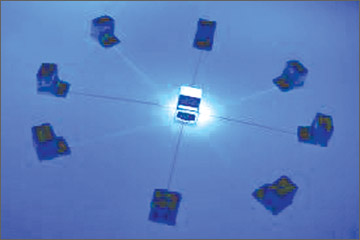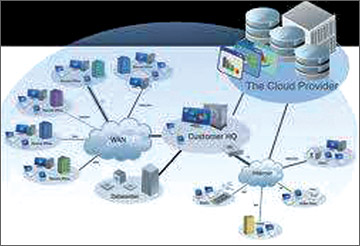Biz-Tech
Journey to the cloud - an evolutionary perspective
Sajid Akbar Country Manager Oracle Fusion Middleware, Pakistan and
South Asia Growth Economies.
|

Sajid Akbar
|
The market has been abuzz with news about the potential of cloud
computing in the past few years, but really, it is embracing an
evolution of sorts for enterprise businesses, one where the cloud is
moving from boardroom conversations to reality.
We envisage the journey to the cloud as a phased one.
In their journey to the cloud - more of an evolutionary process and
not triggered by any particular development or revolution - many
organizations have consistently explored opportunities to strengthen
their existing technology infrastructure to ensure they become a better
internal service provider for various lines of business and
organizational departments.
 Clearly, the objective has been to provide greater agility and
responsiveness to business needs, higher quality of service in terms of
latency and availability, and lower costs and higher utilization. Clearly, the objective has been to provide greater agility and
responsiveness to business needs, higher quality of service in terms of
latency and availability, and lower costs and higher utilization.
Organizations have realized that their datacenters still have
dedicated silos, where each application runs on its own middleware,
database, servers and storage. Each silo is sized for peak load and
therefore there is a significant amount of excess capacity built in.
Each silo is also different, leading to complexity and high costs to
manage.
Organizations are today moving from these silos to a grid or virtual
environment with shared services, dynamic provisioning and standardized
configurations or appliances.
Majority of the companies I talk to are engaged in some form of
consolidation, though they may be doing this in only a portion of their
datacenter.
Many organizations will further evolve to a self-service private
cloud offering the same flexibility and incremental cost advantages to
end users as public clouds, but with less perceived risk and greater
assurances of security and accountability.
This idea is gaining increasing acceptance among large organizations
and according to a survey conducted by a leading analysts firm over 40
percent of around 1,000 organizations surveyed reported plans to
implement some type of private cloud in the next few years.
Similarly, a recent survey conducted among IT and data managers and
professionals with the Independent Oracle Users Group (IOUG) found that
private cloud formations are growing in many companies, often outpacing
adoption of the public cloud.
 In the meantime, we believe public clouds will continue to mature and
eventually create a potent mix of private and public clouds, a “hybrid
cloud”, which will run a single application, managed in a federated
manner, “through a single pane of glass.” In the meantime, we believe public clouds will continue to mature and
eventually create a potent mix of private and public clouds, a “hybrid
cloud”, which will run a single application, managed in a federated
manner, “through a single pane of glass.”
For example, in a cloud-bursting scenario, an organization might run
the steady-state workload on the in-house private cloud, on hardware and
data centres owned by the organization.
But when there’s a peak in the workload (such as at the end of the
financial quarter or ahead of the holiday season), it can dynamically
burst out to a public cloud and take advantage of that capacity.
When the peak is over, return that capacity back to the pool and shed
that cost. We think cloud bursting is still someway off in the future,
but it certainly is very compelling.
Organizations which have adopted SOA in their datacenters will be in
a better position to take advantage of Cloud Bursting.
Organizations will evolve through these basic stages at different
rates of speed, and will occupy several stages all at once. In other
words, organizations will leave some stable legacy applications in a
siloed mode.
They will consolidate other applications to a virtualized, grid
environment. And for some types of applications, they will move to a
full self-service private cloud and ultimately to a hybrid cloud model.
All of this will take time, as we are still in the early days of cloud
computing.
While a move to cloud computing can bring huge operational and
financial rewards, it is a complex task and requires careful planning.
Here are some suggestions for organizations embarking on the cloud
journey:
* Integrated application-to-disk platforms speed up the ability to
exploit cloud computing and reduce business and technology risks.
* Virtualization is a key enabler of cloud computing but managing
clouds is another crucial element. Managing all virtual machines and
clusters is quite complex, especially with self-service, multi-tenancy,
metering for billing and chargeback, and other requirements of cloud
computing. To reap the full benefits of cloud computing organizations
need to choose the right management solution.
* It is imperative for organizations embracing the cloud to take an
approach where security pervades the entire architecture rather than
being bolted on as an afterthought. Organizations should not only look
at products with best-of-breed security in their respective categories,
but also the one where security mechanisms are well integrated, enabling
ease of deployment, ease of change, and high reliability.
In order to reap maximum business benefits from this hybrid cloud
approach, customers must adapt middleware technologies that will
seamlessly bridge this divide and help them continue on their path of
business agility and transformation.
Oracle offers a comprehensive set of cloud computing solutions that
are complete, open and integrated - spanning applications, middleware,
database, operating systems, virtualization, servers, storage,
networking and management of the entire stack.
These include building and managing private platform-as-a-service (PaaS)
and infrastructure-as-a-service (IaaS) clouds, customer options for
running Oracle technology in public clouds or on-premise and enterprise
applications that are deployed on a shared services private cloud as
well as a public cloud model via Oracle on Demand.
Oracle is a cloud computing leader with thousands of customer
successes. For example, Oracle Cloud services have allowed Oracle
University to reduce its hardware consumption to one tenth by increasing
CPU utilization from 7 percent to 73 percent and automatically provision
2,300 environments on a weekly basis.
Oracle University has also been able to reduce power consumption by
40 percent. Credit Suisse built a private, self-service, Java
Platform-as-a-Service using Oracle WebLogic, consolidated over 200
applications onto the platform, saved 35 percent in operating costs,
reduced 85 percent of their servers, and avoided 44 percent power
increase while doubling capacity.
As customers look to further reduce IT costs by hosting shared
services, consolidating workloads on fewer physical resources and
lowering IT administration costs, evolving from a grid to a cloud
platform will become more prevalent.
Van Rees joins MTI
Van Rees, one of the world’s leading tea traders, has just completed
a successful HR assignment with MTI HRM Solutions, for their Sri Lankan
operations.
MTI HRM Solutions (www.mtihrmsolutions.com) is a subsidiary of MTI
Consulting and offers the full suite of HR consulting and advisory
services.
This includes: Integrated Audit and Strategy, Organizational and Job
Design, Recruitment and Selection, Motivation and Talent Retention, HRD
and Training Need Identification, HR Capacity and Manpower Planning,
Performance Management and Employee Engagement and Organizational
Climate Surveys.
MTI HRM Solutions believes that the success of an organization in a
highly competitive environment is significantly influenced by the
organization’s ability to develop and optimize returns from its human
resources.
This requires a strategic and holistic approach to human resource
management.
Virtusa awarded CMMI Level 5 rating
Virtusa Corporation, a global IT services company that offers a broad
spectrum of business consulting and outsourcing services, announced
Thursday that its global delivery framework has been assessed as meeting
the prestigious Capability Maturity Model Integration (CMMI) Level 5
rating, the highest recognition to an organization’s software quality
management system.
CMMI is a process improvement model used to better an organization’s
ability to manage project activities towards success. CMMI is regarded
as the standard in the industry for software and systems development and
management.
Virtusa was awarded CMMI Level 5 based on the company’s superior
accomplishments as a provider of systems engineering, software
engineering and IT services. Virtusa underwent an appraisal in which
independent assessors, along with the internal team, carried out a
detailed assessment of the company’s capabilities at its Advanced
Technology Centre in Hyderabad, India.
The appraisal recognized Virtusa’s innovative global processes for
their high level of maturity. This milestone not only credits Virtusa’s
commitment towards process maturity but also its approach towards
delivery excellence and service quality.
“We are delighted to receive the CMMI level 5 rating, which strongly
validates Virtusa’s commitment to continuous process improvement,” said
Virtusa Chairman and CEO Kris Canekeratne. “It is a testament to the
dedication of our global team members who work relentlessly to improve
our clients’ IT efficiencies through engineering excellence. CMMI level
5 is an industry benchmark and we are honoured to be among a select few
IT service providers who have received this rating,” he said.
The CMMI approach was developed by The Software Engineering Institute
(SEI) at Carnegie Mellon University. Virtusa provides end-to-end
information technology (IT) services to Global 2000 companies. |



